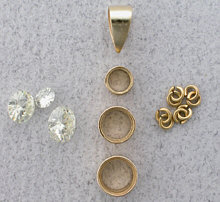How to Make a Three Stone Dangle Pendant
The assembly of this three stone pendant pendant appears simple but when using traditional methods to position and join the tiny parts it can be tricky and time consuming. Each of the bezel units will be connected by jump rings and will dangle when finished. Tack- and pulse-arc welding technology makes the soldering and assembly process easier and more proficient.
1 Minute Read
The assembly of this three stone dangle pendant appears simple but when using traditional methods to position and join the tiny parts it can be tricky and time consuming. Each of the bezel units will be connected by jump rings and will dangle when finished. Tack- and pulse-arc welding technology makes the soldering and assembly process easier and more proficient.
The findings used are 14-karat yellow gold round bezels, jump rings, a pre-made pendant bail.
Important:
All tack-, fusion- and pulse-arc equipment settings will differ and are based upon the volume, amount of contact and alloy of the material you are assembling. Working with like materials will give you a parameter for the settings required for your application. Keep a record of settings and tasks for future reference.
You assume all responsibility and risk for the use of the safety resources available on or through this web page. The International Gem Society LLC does not assume any liability for the materials, information and opinions provided on, or available through, this web page. No advice or information provided by this website shall create any warranty. Reliance on such advice, information or the content of this web page is solely at your own risk, including without limitation any safety guidelines, resources or precautions, or any other information related to safety that may be available on or through this web page. The International Gem Society LLC disclaims any liability for injury, death or damages resulting from the use thereof.
The All-In-One Jewelry Making Solution At Your Fingertips
When you join the Ganoksin community, you get the tools you need to take your work to the next level.
Trusted Jewelry Making Information & Techniques
Sign up to receive the latest articles, techniques, and inspirations with our free newsletter.
